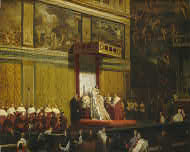
|
Jean-Auguste-Dominique Ingres (artist) French, 1780 - 1867 Pope Pius VII in the Sistine Chapel, 1814 oil on canvas Overall: 74.5 x 92.7 cm (29 5/16 x 36 1/2 in.) framed: 98 x 117 x 8.3 cm (38 9/16 x 46 1/16 x 3 1/4 in.) Samuel H. Kress Collection 1952.2.23 |
Object 6 of 7
Ingres painted this scene while he was living in Italy. The painting's extreme visual accuracy, which reproduces Michelangelo's Last Judgment at the right, is so precise that the painting would appear to be an eyewitness account; however, at that time the pope was being held virtual prisoner in France after having been brutally removed from Rome by French forces following Napoleon's annexation of the Papal States.
The circumstances of the work's commission are somewhat surprising, since Ingres painted it for a prominent French official in Rome who might have been expected to avoid such a potentially controversial subject. He was Charles Marcotte, a good friend of Ingres' and one of his most important patrons, whose portrait is in the Gallery's collection. (Ingres included his self-portrait here on the left, holding a halberd). By the time the painting was exhibited in Paris, events changed dramatically. Napoleon's defeat and exile, the return of Louis XVIII, and the pope's own restoration to Rome removed the controversy from Marcotte's commission.
Ingres, unlike David in whose studio he studied, remained blind to politics, devoting himself instead to the perfection of his art.
| « | back to gallery | » | continue tour |


